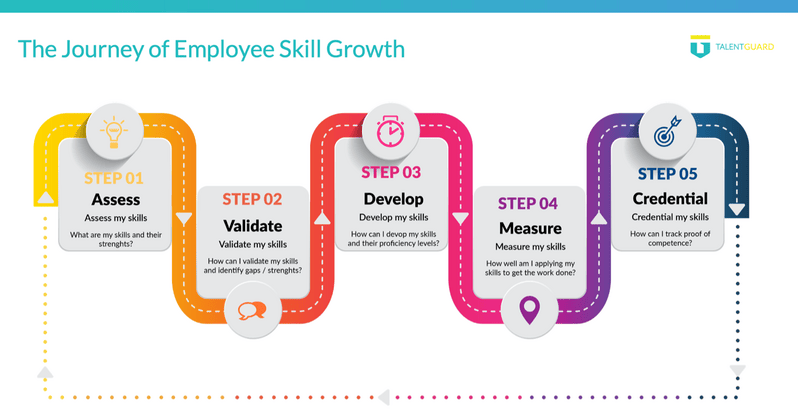The Ultimate Guide To Employee Skill Development

Boost workforce potential with TalentGuard’s 2025 guide to employee skill development —upskill, reskill, and stay ahead in a fast-changing world!
The Journey of Employee Skill Development: Strategies, Examples & Tips
Every organization thrives on the collective expertise of its employees. Whether you run a small start-up or manage a large corporation, the strength of your workforce’s skills can determine how effectively you meet the demands of your industry. When employees’ capabilities are appropriately developed and tracked, companies can remain agile, fill roles internally, and adapt to emerging technologies or shifting market demands. Yet many organizations still underestimate the importance of having a clearly defined process for understanding, validating, and growing these skills over time.
Journey of employee skill growth is key to success—explore strategies to align, develop, and leverage skills effectively. Every employee in your company possesses a certain number of skills and these skills are likely at different levels of proficiency. Your talent could also have additional skills that the business might not be aware of at all. To obtain an accurate picture of all of these skills, organizations must have a way to evaluate and understand this data. Employees’ skill should be assessed when they enter the organization, but also throughout their career. This ensures that their skills are developing, working towards closing skill gaps, and remaining agile over time. You may not be aware that employees’ skills travel through multiple steps in this journey. In this article, we will review the five steps in an employee’s skill journey and their benefits.
This article will explore why skill development matters, how to nurture it, and why mentoring is often the secret ingredient for sustainable growth. We will also look at the five stages in the journey of a skill—Assess, Validate, Develop, Rate, and Credential—to see how each step contributes to an employee’s continuous improvement. By the end, you should have a clear strategy for aligning, developing, and leveraging your company’s talents in a structured yet flexible way.
What Is Employee Skill Development?
>Skill development is the process of improving an individual’s abilities—whether technical, analytical, creative, or interpersonal. The process is about recognizing the current level of proficiency someone has, identifying gaps, and then offering the right resources to help them move to a higher level. This ongoing progression can involve formal training, on-the-job practice, mentoring, and any other method allowing employees to refine and expand their abilities.
>At its core, skill development focuses on the idea that employees are not static in their abilities. Instead, people require continuous growth and new competencies to stay relevant. Change is often the only constant in today’s workforce: technology evolves, roles shift, and entire industries transform. When organizations provide employees with a personalized plan to grow their skills, it keeps their workforce relevant. Employees who feel supported in their growth tend to stay longer and perform better.
The Importance of Understanding the Skill Journey
Skills rarely remain static; they must adapt and expand to keep pace with an evolving work environment. Organizations that treat skill development as a one-time event—such as orientation training or a single upskilling push—may soon discover that their employees lag behind new industry standards. Skill gaps can hamper productivity, limit innovation, and create frustration for managers and team members. Additionally, technology will continue to progress and demand new skill sets of talent as the business progresses. If your employees aren’t moving through the stages in a constant and fluid way, growth and continuing education can be stalled or worse, skill gaps can form.
Your company may have a skills taxonomy or organizational system in place to understand and categorize all the skills within your company. If not, this is a good place to start on your path to understanding where your employees are with their skills. Once skills are categorized and assigned to job roles, employees can start to provide feedback about how proficient they believe they are at a given skill. This is where a skills assessment can be a valuable method for beginning the journey in the lifecycle of your employees’ skills.
By mapping out a skill’s journey, you ensure that employees move through the developmental stages in a fluid, repeatable manner. Each stage provides a clearer picture of where each skill stands and how employees can move forward. When people cycle through these stages consistently, they develop more profound expertise and adaptability to face emerging challenges. It becomes an engine for future readiness.
The 5 Steps in an Employee Skill Development Journey

1. Assess
When an employee first enters the organization—or even if they’ve been there for a while—they should have a way to evaluate their skills. Many companies establish a taxonomy or organizational system that categorizes and defines all the skills relevant to various roles. For instance, a software development team may list skills like programming languages, debugging, and version control.
In this stage, employees self-assess by indicating their perceived proficiency in each skill. This provides an initial snapshot of their capabilities and helps managers guide them toward positions, projects, or future learning tracks that align with what they’re already skilled at—or would like to become proficient in. A well-organized assessment helps the employee and the organization identify starting points for development.
When employee and manager assess and validate skills, skill gaps or a difference in proficiency rating can occur. Learning and development is the solution to closing these gaps and growing new or existing skills. Closing skill gaps can support efforts in working toward an aspirational career move, career path, and even help you to become a candidate in a succession pool. Development can also begin the process of upskilling employees to advance their current career path or reskill them for new roles or departments in the company.
2. Validate
Once skills are self-assessed, how do you ensure that employees’ evaluations are accurate? Self-bias and inaccurate data can be a result of unchecked self-reporting. Therefore, we need to validate their assessment with a manger review. Having a subject-matter expert weigh in on the assessment will also allow us to determine the level of proficiency of each skill, just like a teacher assigning grades to their students.
Self-assessment can offer a valuable baseline but can also be influenced by bias. Some employees underestimate their abilities due to a lack of confidence, while others may inflate their skill levels to appear more qualified. Validating skills through a manager or a subject-matter expert helps correct these discrepancies. This is where an employee’s self-rating is confirmed, adjusted, or refined based on observed performance.
Validation also reduces misunderstandings about an employee’s readiness for specific tasks. The organization obtains more reliable data when an expert verifies a skill level. It’s much like a teacher assigning grades to tests: it ensures everyone has the most precise picture of where the employee stands before moving on to further skill-building steps.
While validating skills gives a starting point for development, rating looks at how well a skill is being utilized on the job daily. An employee may have a skill that falls at a certain proficiency level but knowing this information alone doesn’t tell us how well they are performing this skill at their assessed level. Ratings often come after an annual performance review, but they can also be calculated sooner if wanted or needed. This step is in place to help determine your organization’s ROI on your talent’s skill journey. It answers the question of, how well are they using developed skills to pursue organizational goals?
3. Develop
After assessing and validating, the next logical step is growth. Here, the focus turns to bridging gaps or enhancing existing capabilities. If an employee’s proficiency is lower than the role requires, a learning plan might include specialized training, online courses, or mentorship programs. Even if an employee already meets expectations, development can push them from “meeting” to “exceeding” those expectations.
This stage is critical for any organization that seeks to remain competitive. Technology constantly evolves, and roles that once required primarily manual processes may demand more automation and data-driven decision-making. Development can also address soft skills, such as leadership, communication, or creative problem-solving, ensuring employees become well-rounded and adapt to changing projects or departments.
4. Rate
Knowing that an employee has acquired or improved a skill is one thing. It’s another way to assess how consistently or effectively they apply it in their daily work. Rating typically follows some period of observable performance, which could align with an annual review or occur sooner if needed. For example, if someone learned a new programming language, how effectively are they now using it to deliver software solutions?
An accurate rating offers critical data points for managers and HR professionals. If there’s a notable discrepancy between self-assessment or validation and actual performance, it might be time to revisit training or adjust expectations. Ratings can also spotlight top-performing employees, opening the door for recognition, promotions, or succession planning.
5. Credential
Once an employee has shown true proficiency—often demonstrated by high ratings and observable workplace success—issuance of a credential can be both motivational and practical. A credential could take many forms, from an internal certificate acknowledging completion of a training program to an externally recognized qualification in a particular field.
Credentials serve as a quick reference point, allowing managers and employees to understand expertise at a glance. They also encourage employees to continue climbing the proficiency ladder since attaining a credential feels like a tangible achievement. When updated regularly, these records keep an organization informed about its evolving talent landscape (especially if some credentials expire or require renewal).
Let’s look at an example of an employee moving through the 5 stages:
Peter Gibbons is working as a programmer at the company, Initech. He self-assesses his skills, such as, the computer languages required for his job, his ability to problem solve, and his mathematics education. He will then self-assign his proficiency level in each skill. After his assessment, his skills are validated by his boss, Bill Lumbergh. Bill will confirm or reject that Peter has the skills that he provided and then rank his current proficiency level on each skill. From here, Peter will see the path of development he needs to progress in his career. Once it’s time for Peter’s annual performance review, Bill will review with him how well he is utilizing his skills at work and give him a rating. Once Peter has moved through multiple proficiency levels in his skills, he can look at receiving a credential to back up his skill journey!
As we can see through Peter’s example, a skill evolves over time. Traveling through the skill journey will be an ongoing process to build his knowledge and proficiency level. Moving through this process builds on itself because of the continuous nature of skills and how we interact with them. As talent moves through proficiency levels in current and new skills, they will move through the journey of a skill again and again. Each skill will go through the five steps as they move from a basic skill level to then intermediate, advanced, and expert. They can also move through the journey with many different skills at many different stages. This process allows for continuous employee growth and development to help them be prepared both now and in the future.
Benefits of Skill Development
An organization that encourages skill-building across the workforce reaps multiple rewards. Productivity goes up when employees can handle broader or more complex tasks. Morale often improves because workers see a clear path for career growth. The company also becomes more resilient since a workforce skilled in different areas can better adapt to unexpected changes like technology disruptions or market shifts.
Skill development can reduce turnover, as employees who feel invested are more likely to stay. It also strengthens employer branding—people outside the company see that you prioritize personal and professional growth, making it easier to attract top talent.
Examples of Skills That Can Be Developed
Skills can be both technical and interpersonal. Some technical examples are programming languages, data analysis, project management, and complex design tools. Soft skills include leadership, time management, negotiation, and effective communication. A marketing professional’s skills include search engine optimization, campaign analytics, and copywriting. Developing emotional intelligence and feedback techniques could be equally vital for a manager.
An employee may cycle through the five-step skill journey multiple times across different skill sets. For instance, a marketer learning data analytics might move from novice to advanced over several months, repeating Assess, Validate, Develop, Rate, and eventually Credential when they reach a certain level of mastery.
Development vs. Training
Although the terms are often used interchangeably, development and training differ in scope and intention. Training is often more structured and role-specific, focusing on short-term needs like learning a new software tool. Development casts a broader net, focusing on the individual’s long-term growth. It addresses immediate skill requirements and the broader capabilities needed for future roles and responsibilities.
Both training and development are essential in a modern workplace. Training ensures employees can handle pressing tasks, while development opens doors to leadership, innovation, and new career pathways. One deals with the now; the other prepares for what’s next.
The Bond Between Mentoring and Skill Development
Mentoring can be a powerful accelerator in skill development. A mentor, often a seasoned expert or manager, provides guidance, real-world insights, and encouragement. This relationship can help employees apply newly acquired skills in practical situations, navigate obstacles, and find areas for continuous improvement. Mentoring also bolsters retention by offering a structured support system that keeps employees engaged and motivated.
In many organizations, mentors do more than validate a skill; they help shape how an employee evolves within the company. For example, after an employee completes a training course, a mentor might offer hands-on projects or shadowing opportunities, transforming theoretical knowledge into on-the-job mastery.
Tips for Effective Mentoring for Employee Skill Development
A strong mentoring program requires clarity around goals and expectations. Both mentor and mentee should understand what they aim to accomplish—whether it’s improving a specific skill or exploring multiple areas for growth. Regular, scheduled check-ins allow time to discuss challenges and celebrate small victories.
Mentoring also works best when trust and open communication exist. If the mentee feels hesitant to discuss areas of weakness, the mentor may not be able to provide targeted advice. Pairing mentors and mentees with compatible communication styles and interests further enhances the likelihood of success. Finally, recognizing and rewarding mentors fosters a culture where experienced employees willingly share their knowledge.
Challenges in Mentoring for Skill Development
Despite the clear benefits, mentoring can face hurdles. Time constraints are typical, as both mentors and mentees juggle daily responsibilities alongside their mentoring commitments. Another challenge is skill alignment; if a mentor’s expertise does not match the mentee’s developmental goals, the program may fail to deliver meaningful results.
There can also be a lack of clear metrics to measure mentoring success. Organizations struggle to assess the true impact without concrete ways to track progress. Setting up key performance indicators or milestones—like the five-step skill journey—can ensure that mentoring outcomes are visible and actionable. A well-structured environment with tools, oversight, and administrative support helps mitigate these challenges.
Journey of Employee Skill Growth Where to Start?
How do you start the journey of employee skill growth? The short answer is that you need an all-in-one platform, not a point solution for each step. Progressing and monitoring this cycle requires in-depth skill data analysis that is available quickly, is updated regularly and communicates across all steps in the journey of the skill. You’ll need a way for your talent assessment to connect with your manager review process and be able to pull skill information from the company database to create career paths. This will allow your employees to have a clear development path and then be graded on their individual progression accurately. Once certificates or credentials are earned, they must be logged and attached to each employee’s profile in a way that is easy to see. This allows them to be updated accordingly if they include expiration or renewal dates to avoid certification lapses and work delays. This organizational communication helps businesses obtain a large-scale, accurate picture of all their internal skills. In turn, having access to data and resources at each step of the process, creates a culture of learning that helps skills remain optimized and allows employees to be better prepared for both now and the future.
To learn more about the journey of employee skill development, request a demo.
Frequently Asked Questions:
What is skill development in the workplace?
Skill development in the workplace involves systematically identifying, nurturing, and enhancing employees’ capabilities to meet both current and future job demands. It typically includes formal training, hands-on practice, mentorship, and continuous feedback. When done well, skill development ensures that teams stay agile, adapt to evolving technologies, and collaborate more effectively. It also helps individuals see clear paths for career growth and leadership opportunities, creating a work culture where learning is an ongoing priority rather than a one-time event.
What are your top 3 skills development priorities?
- Technical Proficiency: Employees need up-to-date technical training to keep pace with industry changes and master new tools, software, or methodologies relevant to their roles.
- Soft Skills Enhancement: Building strengths in communication, problem-solving, and teamwork helps employees collaborate effectively and adapt to varied workplace scenarios.
- Leadership & Management: Focusing on strategic thinking, coaching, and conflict resolution equips future leaders with the skills to guide teams and foster innovation.
What is the meaning of employee development skills?
Employee skill development refers to a combination of technical, interpersonal, and conceptual abilities that employees cultivate over time to grow professionally. These skills encompass everything from job-specific tasks—like coding or financial analysis—to broader talents such as emotional intelligence or leadership. By focusing on continual learning and practical application, organizations help employees evolve in their roles, align with strategic objectives, and become more resilient to market or technological shifts.
Other Resources:
Learning from Layoffs: Skills, Data and Alternatives to Consider
Learning from layoffs: We saw an inevitable spike in layoffs across many industries as companies scrambled to adjust. Two years later, we are still witnessing high numbers of layoffs with the largest spike since the beginning of the pandemic occurring very recently in May 2022. Companies are citing increased costs and decreased profits as the […]
How to Solve Manufacturing’s 3 Biggest Skills-Based Challenges
While the chaos of the pandemic affected all industries, manufacturing may have been one of the most directly impacted. Extreme supply chain issues affected cost, timing, production, and labor in such a substantial way that many companies were scared they wouldn’t be able to recover. The expectation for the aftermath of the pandemic was that […]
Dynamic Skill Management Approaches in Business
Dynamic skill management approaches help organizations navigate today’s fast-paced business environment, where rapid technological advancements and pandemic-era disruptions are reshaping the workforce. The constantly shifting demands for skills and competencies require companies to adopt flexible strategies that align with evolving industry needs and support employee development. The pace of digital and industry advancements demands employees […]



